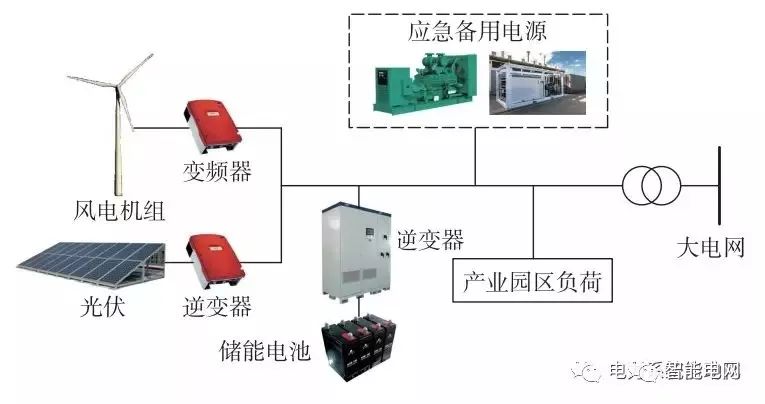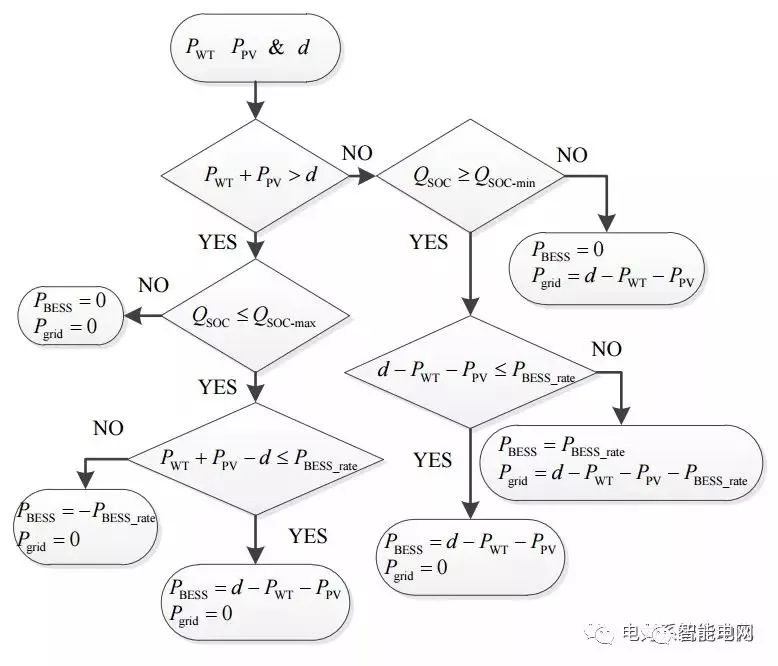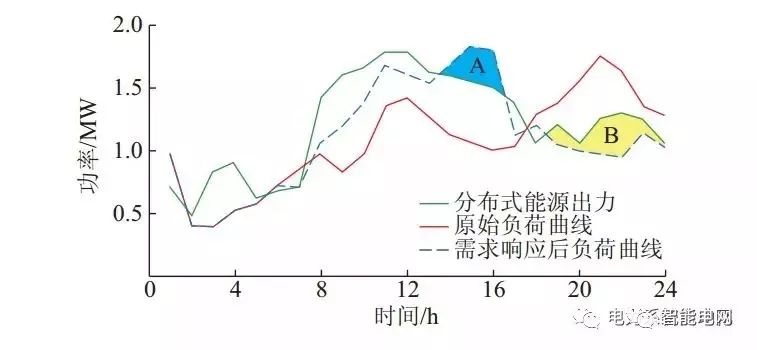Research on Capacity Allocation of Power Supply System in Industrial Parks under the Background of New Electricity Reform
Research background
With the new round of reform of the power system throughout the country, the industrial park has become the most important reform pilot for the distribution side because of its large power consumption, various forms of energy use, and good independence of power supply. At the same time, the use of distributed new energy generation to replace the traditional distribution network centralized power supply mode is one of the important trends in the development of the industrial park power supply system.
The traditional industrial park power supply system planning generally only includes two aspects: load forecasting and line network design. The emergence of distributed power supply makes the power-side capacity optimization and configuration issue a key issue in the planning of the industrial park power supply system. The existing research mainly revolves around the capacity optimization configuration model and the solution algorithm. Most of them are limited to the pure power supply side optimization. There is less research on the influence of the load side when the capacity is optimized. With the gradual release of the electricity distribution side, the electricity pricing mechanism for placing will be more flexible, and the temporal and spatial distribution characteristics of electricity users' electricity consumption will be affected by the electricity price mechanism. This will make load forecasting more uncertain and increase. The difficulty of load forecasting; on the other hand, the flexible price mechanism also contributes to the implementation of Demand Response (DR), increases the flexibility of the load side operation, and provides a further optimization space for the power supply side.
Existing researches have analyzed the optimal allocation of distributed power capacity from aspects of generation side, demand side, and energy storage. The disadvantages are related to the comprehensive use of multi-energy complementary characteristics, demand-side response, and source-reservoir-load Coordinating and interacting relations to deepen the power balance relationship in the distribution network and further realize the research on the optimal distribution of distributed power/energy storage system in distribution networks has not yet been carried out. In addition, most of the existing studies are DR-based interruptible loads, while less research is conducted on tariff-based DRs that have large impact on the pricing of the electricity distribution. Based on this, this article has carried on the research of the optimal configuration method of the distributed power/energy storage system of the industrial park power supply system.
2. The main technical route
This paper first analyzes the energy management strategy of the industrial park power supply system and the complementary characteristics of the distributed wind power generation system, and proposes a complementary evaluation index of wind and solar energy storage; introduces the demand side response mechanism based on the daily time-of-use price, and uses the electricity demand elasticity matrix to establish the demand side. The response model and the demand-side response model based on the traditional electricity demand elasticity matrix have problems such as unbalanced power transfer and excessive demand response, and proposes an improved demand-side response model; on this basis, the minimum total cost is established. Optimize the configuration model of the distributed power supply and energy storage system in the park's power supply system, and use the combined intelligent algorithm combined with the pattern search algorithm to solve the optimization configuration model; finally use a typical example to optimize the proposed configuration. The method was analyzed and verified.
3. Analysis of Operation Characteristics of Power Supply System in Industrial Parks
3.1 System Energy Management Strategy
The topology of the power supply system of the wind-cum-storage-complementary multi-energy complementary industrial park studied in this paper is shown in Fig. 1. The system can not only obtain electric energy from the large-scale power grid, but also can include photovoltaic power generation systems, wind power generation systems, and energy storage systems. powered by. In addition, power generation equipment such as diesel generators and fuel cell systems are usually deployed in industrial parks as an emergency backup power source for major power grid failures. The configuration of these backup power supplies must be based on relevant requirements in terms of primary load, fire load, and certain owners’ requirements. The secondary important load capacity is calculated.

Figure 1 Structure of Power Supply System in Industrial Park
Since the distributed power supply/storage capacity configuration is closely related to the energy management strategy of the power supply system, the energy management strategy adopted by the power supply system in this paper is shown in Figure 2.

Figure 2 Energy Management Strategy
3.2 Multi-energy Complementary Characteristics Analysis and Evaluation Index
Multi-energy complementary is a power supply mode that uses multiple types of distributed power sources and uses the complementary characteristics between different distributed power sources to improve the output characteristics of distributed power sources. For example, solar energy and wind energy each have strong intermittentity and volatility, but they have strong complementarity in time distribution: when the light intensity is strong during the day, the wind is relatively small, and there is no light at night, but the wind energy is strong; The light intensity is strong and the wind is small. In winter, the light intensity is weak and the wind is large. Obviously, by using complementary features of solar energy and wind energy, wind-solar hybrid power generation methods can improve the output characteristics of distributed generation. At the same time, on the basis of complementary wind and solar energy, adding appropriate energy storage systems can further optimize the multi-energy complementary properties.
This paper proposes that the distributed power supply power shortage ratio and the distributed power supply power supply hours are less than two indicators to characterize the multi-energy complementary characteristics.
4. Demand-side response modeling based on daily time-of-use price
Because the limitations of real-time electricity price measurement accuracy, real-time communication, and management costs are difficult to promote, the power users can make more reasonable arrangements in advance by formulating DayAheadRealTimePrice (DARTP) on the second day. The two-day electricity plan is conducive to the implementation of multi-period demand-side responses.
The 24-hour demand-side response model established using the electricity demand elasticity theory. In an ideal situation, the demand-side response caused by the current time-of-use price will only change the time distribution of electricity demand, and its total electricity demand will not change. However, the demand-side response model does not guarantee that the power requirements moved in and out of the day will be equal. In addition, the DR model also has the problem of over-response. As shown in Fig. 3, in the period corresponding to area A, the original renewable energy output is larger than the power demand, but after the demand-side response is implemented, the renewable energy output is smaller than the power demand, and the power demand is excessively moved into this period. Lead to unnecessary energy storage system operating costs and large grid power supply. In the period corresponding to area D, the situation is just the opposite. Excessive removal of power demand will lead to an additional demand side responding to the cost of electricity subsidy, and causing unnecessary wind abandonment.

Figure 3 DARTP-DR Over Response
Based on the above analysis, this paper proposes a DR model correction method based on power demand elastic matrix.
5. Capacity optimization configuration method
The capacity optimization configuration model was established based on the optimization objective function of the minimum total net present value of the power supply system of the industrial park. The net present value of comprehensive cost includes the net present value of initial investment cost, net present value of operation and maintenance cost, net present value of renewable energy generation income and net present value of DR implementation cost. In order to simplify the calculation, it is assumed that the power supply system of the industrial park will use the same electricity and the renewable energy price subsidies will be the same.
In this paper, a power supply system in an industrial park in a certain area is used as a simulation example to verify the proposed capacity optimization method. In order to give consideration to the flexibility of wind power system control and single generation capacity, the selected wind power system is a 100kW variable pitch permanent magnet direct drive wind turbine. The 8760 hour data of wind speed, irradiance and load comes from the Bureau of Meteorology and the power company. The elasticity coefficient of electricity demand is obtained through the actual investigation and analysis of the electricity consumption of the industrial park users.
After simulation calculation, the optimized configuration results of distributed power supply/storage capacity of the industrial park power supply system with no demand-side response, a traditional demand-side response model, and an improved demand-side response model are shown in Table 1. The three configurations are six 100kW wind turbines and 1484kW photovoltaic. When there is no demand side response, the energy storage system configuration capacity is 3882kW ̇h, the rated power is 1066kW, and the configuration capacity of the energy storage system when using the traditional demand side response model For 3623kW ̇h, rated power is 931kW, when the improved demand-side response model is used, the energy storage system configuration capacity is 3589kW ̇h, the rated power is 919kW, and there is no battery replacement of the energy storage system 6 times when there is no demand side response, However, when the traditional demand-side response or the improved demand-side response model was adopted, the energy storage battery was reduced to four times. The overall cost of the three configuration options was 31.06 million yuan, 26.92 million yuan, and 25.88 million yuan respectively. Obviously, due to the elimination of DR over-response problem, the capacity configuration scheme using the improved demand response model is more economical than the capacity configuration scheme using the traditional demand-side response model.

Table 1 Capacity Optimization Configuration Results
6. Conclusion
1) Because the current cost of energy storage systems is still relatively high, simply using energy storage systems to adjust the mismatch between the distributed power supply and the industrial park electricity load is too costly. This paper proposes an optimal capacity allocation method for the power supply system of industrial parks. Focusing on the impact of multi-energy complementarity and source storage-and-sequence synergy characteristics on optimal capacity allocation, it can effectively reduce the overall cost of power supply system capacity configuration.
2) For the multi-energy complementary characteristics of wind and solar energy storage, this paper proposes two ratios of distributed power supply power shortage and distributed power supply power shortage hours. Through these two indexes, the relationship between the multi-energy complementary characteristics and the overall cost of the power supply system configuration of the industrial park is described. At the same time, the power shortage ratio of the distributed power supply can also reflect the implementation of the demand-side response from the perspective of multi-energy complementary characteristics. effect.
3) Using the electricity demand elasticity matrix to model the demand-side response based on the daily time-of-use price, and to address issues such as load transfer balance and demand-side over-response, a corresponding demand-side response model correction method was proposed to improve the demand side. In response to the rationality and accuracy of the model, this study has practical significance and reference value for implementing the demand-side response mechanism based on the hourly electricity price of the industrial park. (Wu Ming, Ren Xuejun, Zhou Dan, Su Jian, Yan Lingfeng, Liang Huishi)
Nantong Boxin Electronic Technology Co., Ltd. , https://www.ntbosen.com